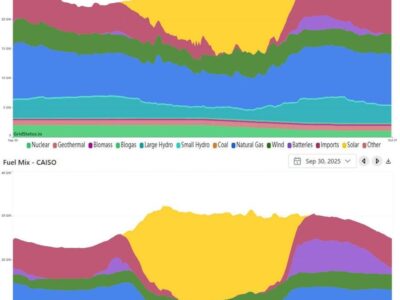Talking Climate Policy with an Energy Economist
An interview with leading energy expert Catherine Wolfram
I had the chance to talk about climate policy with Catherine Wolfram, a leading energy economist who has researched the impact of the Inflation Reduction Act. She was a longtime faculty member in Berkeley’s Haas Business School. She went to Washington to serve as the Deputy Assistant Secretary for Climate and Energy Economics at the US Treasury in 2021-2022, and from there went on to join the MIT faculty.
With that as background, this is a write-up of our conversation.
Farber: You were involved in extensive modeling of the Inflation Reduction Act’s impact after its passage. What’s your assessment of the law at this point? Which parts of the law have the greatest positive impacts?
Wolfram: I think the topline assessment of our research still holds. We predicted expenditures much higher than originally forecast by the Congressional Budget Office and Joint Committee on Taxation, and we also expected to see a lot of emissions reductions but not enough to get to a 50% cut. (The US Nationally Determined Contribution is a 50% reduction from 2005 levels by 2030}. Those things are still true now. There was some variation from our forecast, with less investment in wind and more in solar than expected.
In terms of the IRA’s strengths, I personally really like the expenditure on nascent technologies like carbon capture and sequestration (CCS), direct air capture, and CCS pipelines. These seem like the kind of things that government should be spending money on – early-stage technologies. I also like the fact that the IRA, as I see it, lays the groundwork for future climate policy, including a carbon price at some point. It does this by making it cheaper for consumers to move away from fossil fuels.
Farber: Could you say a little more about the role of innovation in climate policy?
Wolfram: Innovation policy is a key part of climate policy. There are huge spillover effects from support for the bench science and later development efforts needed to commercialize a new technology. If we can prove out technologies, there are huge benefits to the climate efforts of other countries. Given that the U.S. currently accounts for only a bit more than 10% of global emissions, spillovers to the rest of the world are first-order, crucial aspects of any U.S. policy.
Farber: Now that we’ve talked about the IRA’s potential impact, let’s talk about the elephant in the room: the risk of repeal. Do you have a sense of which parts of the IRA are at the greatest risk?
Wolfram: There’s some chance that the GOP won’t be able to get it together to do much of anything to the IRA, given their small margins in Congress. There are some pockets like the methane fee that seem to be on the chopping block, which is opposed by the American Petroleum Institute. I see EV subsidies as more at risk than electricity sector subsidies. On a dollar-per-ton basis – in other words, the cost of reducing a ton of carbon emissions – these subsidies are expensive, while things like the production and investment tax credits for zero-carbon electricity are much more cost-effective.
Farber: How would you assess the energy policies of the incoming administration? Do you expect to see large impacts on U.S. fossil fuel production or on clean energy development?
Wolfram: The Treasury Secretary wants a 3 billion barrel-per-day increase in oil production, but that would be a huge expansion: a more than 20% increase compared to current levels, which are already at record high levels. Honestly, the Administration will feel pressure from two sides – industry would like to produce more, but if they expand that much it will drive prices down. So, the industry will resist expansion past a certain point. But if the Administration wants lower prices for consumers, they will need a huge expansion in production. So, there are tensions. Frankly. I doubt there are enough levers for them to pull to get the kind of expansion they’re talking about.
Farber: Will they have a big impact on wind and solar?
Wolfram: Probably not. A lot of those investments are going into Red states, so Congress seems unlikely to want to slow those investments down. On the other hand, I recently saw a headline that the state of Oklahoma wants to ban renewable investments. As that goes to show, politics can outweigh constituent interests.
Frankly, I think the most detrimental impacts of the Trump Administration will be on international climate issues, like his promise to withdraw from the Paris Agreement. Will that set off a vicious cycle where a bunch of countries withdraw?
Farber: As an energy economist, do you see areas where there might be room for constructive policy developments in the next four year?
Wolfram: Permitting reform. Everyone always talks about that as having bipartisan potential. We’ll see whether they can make progress on that. There’s a lot of talk about carbon tariffs too.
Farber: While we’re on the subject of international trade, I know that you’ve done recent research on carbon border adjustment mechanisms like the EU’s CBAM. Would you like to say anything about that?
Wolfram: CBAM is different from what the U.S. is proposing because the EU and the UK, which have CBAMs, have carbon prices themselves. So the CBAM is an equalizer, which makes it nondiscriminatory. CBAM has already started to have some important spillover effects. It has sparked a global conversation on carbon pricing. This has sparked a virtuous cycle.
What the U.S. is talking about is basically a tariff. There would be a carbon price on Chinese steel but not U.S. steel. The U.S. approach is so unfair that it may disrupt the conversation started by CBAM about carbon pricing.
Farber: Turning from the federal to the state level, what role do you see for state climate policies in the Trump era?
Wolfram: The important question is how what the U.S. does spills over to other parts of the world. States have fewer levers. They can’t enact tariffs. That said, California has been very effective in being a testing ground, like how do you run a grid with very high renewables penetration? What California learns from its regulatory innovations can have very positive effects elsewhere.
Farber: I think we’re out of time at this point. Thanks so much for sharing your views with our readers.
Reader Comments
2 Replies to “Talking Climate Policy with an Energy Economist”
Comments are closed.






Thanks for those insights. I am concerned that we seem to think we can buy/build our way out of the global warming crisis. The first law of life is the second law of thermodynamics, the entropy law: you cannot get more out of a system than you put into it. Where does that leave us with our current economic and energy policies? I don’t know.
David asked?
“….Where does that leave us with our current economic and energy policies? I don’t know…”
Dear David,
You are correct that we cannot buy/build our way out of that elusive “climate crisis”. However, we can do what humanity has done before and adapt.
Adaptation is much easier and more relaxing than endless struggling and trying stop the climate from changing. Climate is gonna change, don’t worry, be happy.